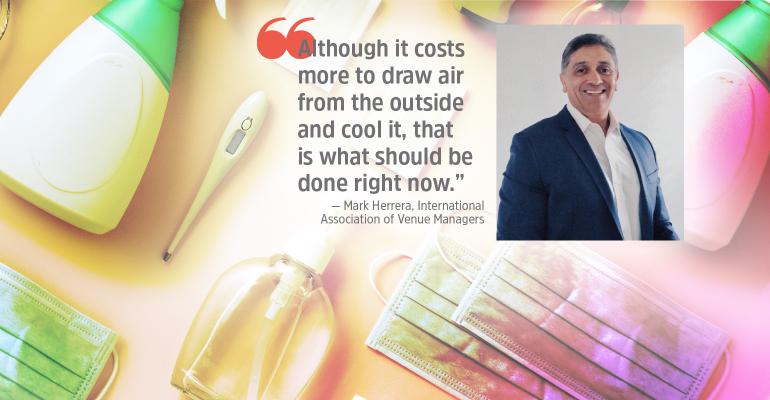When the Covid-19 pandemic took hold, the meetings and hospitality industry stepped up to figure out the best ways to keep surfaces in an event venue germ-free. Hotel companies delivered new protocols such as Hilton’s CleanStay program and Marriott International’s Global Cleanliness Council; destinations began certification programs, for example, Singapore’s SG Clean; and the well-regarded Global Biorisk Advisory Council’s STAR Accreditation launched for any venue to achieve.
However, scientific research has shown that airborne transmission of Covid-19 is common and must be accounted for in order to make event spaces safe. Besides cleaning surfaces and requiring face masks of a certain minimum quality, venues also need good air ventilation. Because of this, “HVAC systems are at the forefront of the conversation,” says Mark Herrera, director of education and life safety for the International Association of Venue Managers. He’s consulted with scientists and engineers involved with the GBAC STAR initiative to understand “how they build the most effective systems for cleaning and pushing air through event facilities.”
According to those experts, good ventilation requires significant direct air flow; HEPA or MERV-13 air filters; and negative-pressure systems or portable filters in any spaces where air can become stagnant. First, direct air flow means that at least some of the air drawn into the ventilation system is released to the outdoors rather than recirculated, with outdoor air drawn in to replace it.
“Although it costs more to draw air from the outside and cool it, that is what should be done right now,” Herrera says. “Planners should ask the facility to optimize HVAC system settings for effectiveness versus cost efficiency.” Specifically, this means disabling an effect called “demand-control ventilation” while also ensuring that air-side economizers are used to the fullest, which maximizes fresh-air exchange during occupied periods.
Also, the relative humidity of the air should stay between 40 and 60 percent to minimize particle transmission—lower humidity would allow greater particle-travel distance, while higher humidity causes particles to land and remain on surfaces.
Next, planners should ask facility managers when the MERV-13 or HEPA filters in the HVAC system were last cleaned or replaced, Herrera says. What’s more, suggests Herrera, “ask about the possible use of UV disinfecting lights within air-handling units or supply ductwork, especially if a facility’s system is in danger of being overworked from increased filtration demand.”
Negative air pressure, where the full volume of a room’s air is pulled strongly upward and out of the room in just a few minutes, should be employed in restrooms and other small enclosed spaces to ensure that exhaled air is drawn away from people and filtered before being re-inhaled. However, if a facility’s restrooms, breakout rooms, or other confined areas do not use a negative-pressure system, portable MERV-13, HEPA, UV, or ion-plasma air filters could be placed in those spaces. Richard Corsi, dean of the Maseeh College of Engineering and Computer Science at Portland State University, purchased 12 such units for campus classrooms of up to 1,000 square feet. “Portable HEPA filters can significantly lower risks of Covid-19 exposure in classrooms,” he says.
Herrera’s other concern is the use of standing fans or ceiling fans that blow unfiltered air back through a gathering space, which can increase transmission risk. His advice: “Reduce fan speeds and redirect them from tables. Similarly, air-conditioning vents should not blow across the crowd—redirect them as necessary. You have to balance safety and comfort.”





